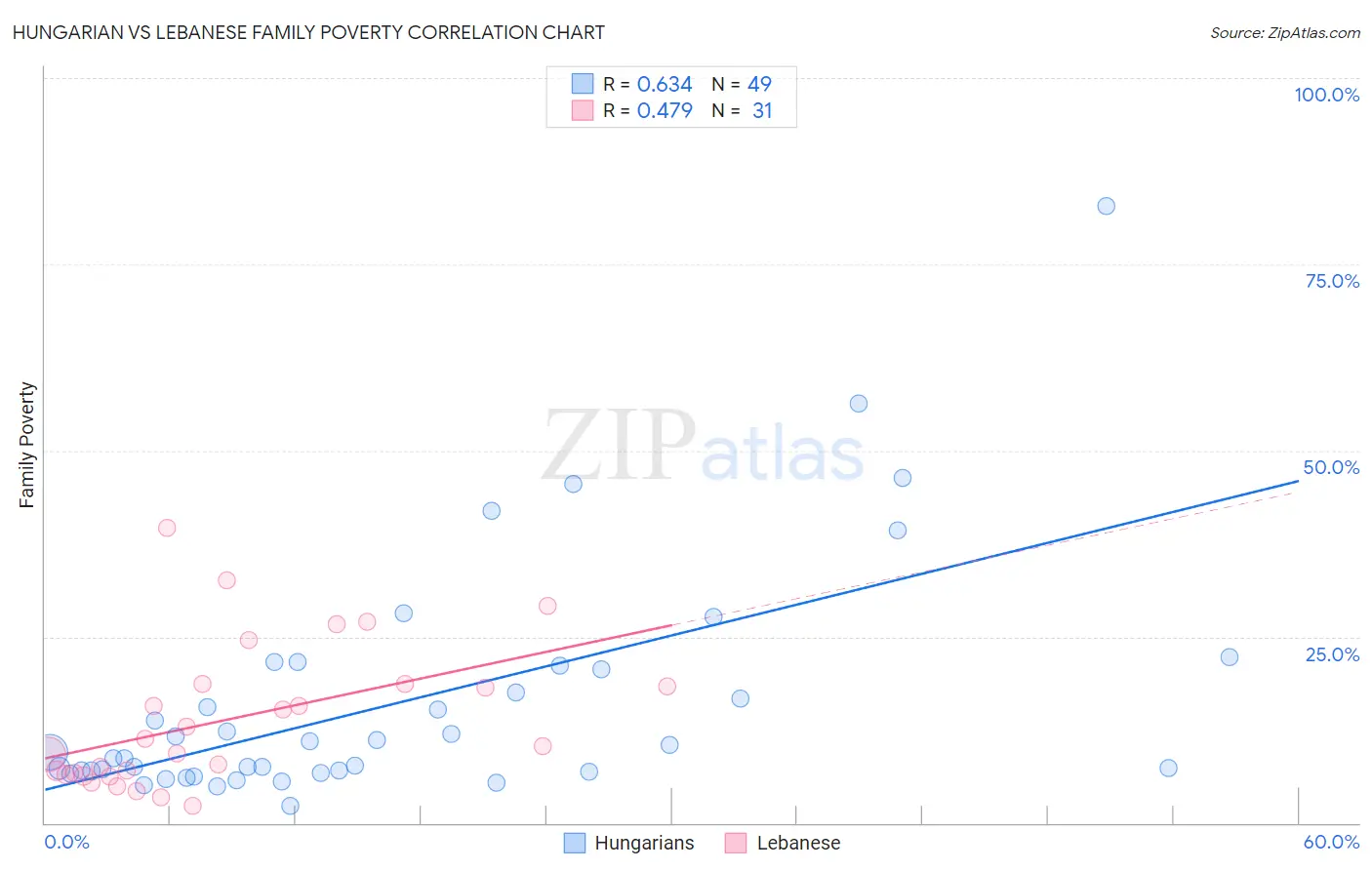Hungarian vs Lebanese Family Poverty
COMPARE
Hungarian
Lebanese
Family Poverty
Family Poverty Comparison
Hungarians
Lebanese
8.8%
FAMILY POVERTY
67.2/ 100
METRIC RATING
160th/ 347
METRIC RANK
8.9%
FAMILY POVERTY
57.6/ 100
METRIC RATING
171st/ 347
METRIC RANK
Hungarian vs Lebanese Family Poverty Correlation Chart
The statistical analysis conducted on geographies consisting of 483,762,053 people shows a significant positive correlation between the proportion of Hungarians and poverty level among families in the United States with a correlation coefficient (R) of 0.634 and weighted average of 8.8%. Similarly, the statistical analysis conducted on geographies consisting of 400,253,340 people shows a moderate positive correlation between the proportion of Lebanese and poverty level among families in the United States with a correlation coefficient (R) of 0.479 and weighted average of 8.9%, a difference of 1.4%.

Family Poverty Correlation Summary
| Measurement | Hungarian | Lebanese |
| Minimum | 2.4% | 2.3% |
| Maximum | 82.8% | 39.7% |
| Range | 80.4% | 37.3% |
| Mean | 16.1% | 13.8% |
| Median | 9.5% | 10.4% |
| Interquartile 25% (IQ1) | 6.9% | 6.5% |
| Interquartile 75% (IQ3) | 20.9% | 18.7% |
| Interquartile Range (IQR) | 13.9% | 12.2% |
| Standard Deviation (Sample) | 15.7% | 9.5% |
| Standard Deviation (Population) | 15.6% | 9.4% |
Demographics Similar to Hungarians and Lebanese by Family Poverty
In terms of family poverty, the demographic groups most similar to Hungarians are Immigrants from Northern Africa (8.8%, a difference of 0.040%), Peruvian (8.8%, a difference of 0.13%), Ethiopian (8.8%, a difference of 0.13%), Pennsylvania German (8.8%, a difference of 0.18%), and White/Caucasian (8.8%, a difference of 0.30%). Similarly, the demographic groups most similar to Lebanese are Immigrants from Peru (8.9%, a difference of 0.010%), Kenyan (8.9%, a difference of 0.080%), Immigrants from Fiji (8.9%, a difference of 0.16%), Immigrants from Chile (8.9%, a difference of 0.27%), and Israeli (8.9%, a difference of 0.62%).
| Demographics | Rating | Rank | Family Poverty |
| Immigrants | Kuwait | 73.6 /100 | #155 | Good 8.7% |
| Immigrants | Oceania | 71.2 /100 | #156 | Good 8.7% |
| Tsimshian | 69.3 /100 | #157 | Good 8.8% |
| Whites/Caucasians | 69.1 /100 | #158 | Good 8.8% |
| Peruvians | 68.0 /100 | #159 | Good 8.8% |
| Hungarians | 67.2 /100 | #160 | Good 8.8% |
| Immigrants | Northern Africa | 66.9 /100 | #161 | Good 8.8% |
| Ethiopians | 66.3 /100 | #162 | Good 8.8% |
| Pennsylvania Germans | 66.0 /100 | #163 | Good 8.8% |
| Celtics | 64.9 /100 | #164 | Good 8.8% |
| Guamanians/Chamorros | 64.7 /100 | #165 | Good 8.8% |
| Afghans | 63.5 /100 | #166 | Good 8.8% |
| Immigrants | Ethiopia | 62.5 /100 | #167 | Good 8.9% |
| Israelis | 62.1 /100 | #168 | Good 8.9% |
| Immigrants | Chile | 59.6 /100 | #169 | Average 8.9% |
| Kenyans | 58.2 /100 | #170 | Average 8.9% |
| Lebanese | 57.6 /100 | #171 | Average 8.9% |
| Immigrants | Peru | 57.5 /100 | #172 | Average 8.9% |
| Immigrants | Fiji | 56.4 /100 | #173 | Average 8.9% |
| Immigrants | Albania | 50.0 /100 | #174 | Average 9.0% |
| Costa Ricans | 49.3 /100 | #175 | Average 9.0% |